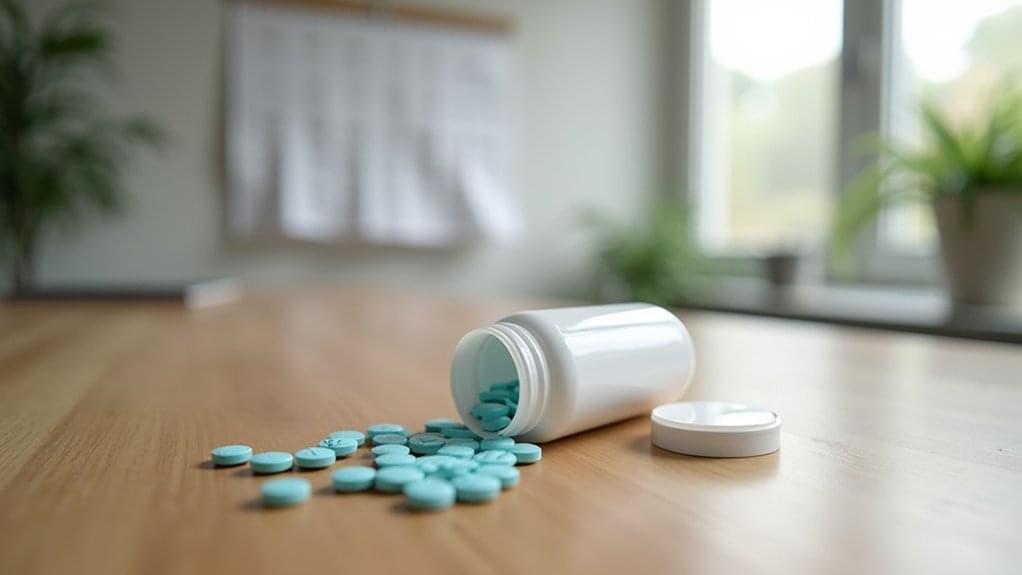Recovery works through five predictable stages: precontemplation, contemplation, preparation, action, and maintenance. You’ll likely cycle through these stages multiple times, that’s completely normal and expected. The process begins when you acknowledge addiction’s negative impact on your life, followed by medical detoxification under professional supervision. You’ll then engage in behavioral therapies, build supportive relationships, and develop coping strategies. With over 54% achieving recovery without formal treatment, multiple pathways exist to help you discover what works best for your unique situation.
Understanding the Five Stages of Change in Recovery

Recovery from addiction isn’t a single moment of transformation; it’s a process that unfolds through distinct, predictable stages. You’ll likely begin in precontemplation, where you might not recognize substance use as problematic. As awareness grows, you’ll enter contemplation, maneuvering ambivalence between the positives and negatives of use while resolving inconsistencies in your thinking.
The preparation stage marks your decision to change, developing concrete plans for recovery. During action, you’ll implement sustained behavioral changes like attending therapy or support groups. You may find yourself building a sober network of supportive relationships that replace connections centered around substance use. Finally, maintenance focuses on consolidating new habits and preventing relapse. This stage requires ongoing support for at least six months to effectively prevent relapse and maintain your new healthy behaviors.
Understanding these stages helps normalize the non-linear nature of recovery. You might cycle between stages, and that’s completely normal, each step forward builds your foundation for lasting change. Most people go through the stages multiple times before achieving lasting success, with research showing it typically takes 3-4 attempts.
Recognizing When You’re Ready to Begin the Recovery Process
Recognizing your readiness for recovery often begins with acknowledging that substance use has created negative consequences in your life, marking a pivotal shift away from denial. You might notice warning signs like increased stress, isolation from loved ones, or erratic behaviors that signal it’s time to contemplate change. This recognition doesn’t happen overnight, research shows that 74.8% of adults who’ve addressed substance use problems identified specific moments when they realized the need for recovery, demonstrating that readiness is both a personal revelation and a measurable turning point. Understanding that recovery attempts typically require multiple efforts can help normalize the process, as studies show the median number of recovery attempts among those who resolved significant substance use problems was 2 attempts. Studies examining pre-treatment readiness have found that problem recognition influences treatment readiness primarily through a desire for change rather than simply wanting help from others. It’s important to know that over 54.1% of people achieved recovery without formal treatment, showing that multiple pathways exist for those ready to begin their recovery journey.
Signs of Readiness
When you’ve been struggling with addiction, determining whether you’re truly ready to begin recovery can feel overwhelming, yet recognizing these signs marks a pivotal turning point in your journey. Developing introspective skills helps you honestly assess your situation, while nurturing self-compassion allows you to move forward without harsh self-judgment.
| Internal Readiness Signs | External Action Signs |
|---|---|
| Persistent thoughts about needing change | Actively seeking treatment information |
| Acceptance that addiction controls your life | Reaching out to support networks |
| Willingness to face withdrawal symptoms | Creating distance from triggers |
You’ll likely notice increased concern about health consequences and genuine motivation to pursue sobriety. These indicators suggest you’re prepared to embrace accountability, seek professional guidance, and commit to the challenging but rewarding recovery process ahead. Despite fears about social stigma, acknowledging your need for help demonstrates the courage necessary to begin meaningful recovery work. Many individuals experience an identity crisis where they feel completely disconnected from their true self, which often serves as a powerful catalyst for entering treatment. An important first step involves confiding in trusted family members or close friends who can provide emotional support throughout your recovery journey.
Moving Beyond Denial
Breaking through denial represents one of the most challenging yet essential steps in your recovery journey, as this powerful psychological defense mechanism has likely protected you from confronting painful truths about your addiction. You might’ve minimized consequences, justified your substance use, or convinced yourself you don’t fit the stereotype of someone with addiction. This resistance often intensifies due to fear of withdrawal, stigma, or losing relationships tied to your current lifestyle.
Moving beyond denial requires self-forgiveness as you acknowledge the full impact of addiction on your life. This process involves grief for your former identity, but it’s necessary for identity transformation. Understanding that denial operates on both conscious and subconscious levels helps explain why breaking through it can feel so overwhelming and confusing. During this stage, you may find yourself blaming others and circumstances rather than drawing logical conclusions about your addictive behavior. The recovery process itself varies significantly depending on the specific substance involved and the severity of your addiction. Education about addiction, supportive confrontation from loved ones, and witnessing others’ recovery success can catalyze this shift toward acceptance and genuine readiness for change.
Medical Detoxification and Initial Treatment Options

Once you’ve decided to begin recovery, medical detoxification often serves as your first pivotal step toward sobriety. You’ll work with healthcare professionals who provide supervised withdrawal management, ensuring your safety while your body clears itself of substances. This process also helps you identify the most appropriate treatment program based on your specific needs and circumstances. The detox process involves several key stages, including identification of your substance use history, gradual cessation under medical care, moderating withdrawal effects, and continuous monitoring of your vital signs throughout treatment. For opioid dependence, medications like methadone or buprenorphine may be used for stabilization and maintenance during this critical phase.
What Is Medical Detox
If you’re considering addiction treatment, medical detox represents the pivotal first step that safely removes substances from your body while managing withdrawal symptoms under professional supervision. This medically supervised process stabilizes your physical health and prepares you for psychological addiction treatment through evidence based protocols.
| Detox Phase | Duration | Key Focus |
|---|---|---|
| Evaluation | 1-2 days | Medical history, risk assessment |
| Stabilization | 2-120 days | Withdrawal symptom management |
| Change | 1-3 days | Treatment planning, referrals |
During detox, physician-led teams monitor your vital signs continuously while administering medications like buprenorphine for opioids or benzodiazepines for alcohol withdrawal. You’ll receive customized treatment based on your substance use, medical condition, and withdrawal severity. The detox process typically lasts 7-10 days on average, though duration varies based on your individual addiction severity and withdrawal symptoms. Remember, detox alone doesn’t address addiction’s psychological aspects—it’s your basis for all-encompassing recovery.
Supervised Withdrawal Management Process
Supervised withdrawal management follows a systematic five-phase approach that safeguards your safety while your body eliminates addictive substances. Healthcare professionals conduct thorough assessments using standardized tools like CIWA or COWS to evaluate your withdrawal severity and create an individualized treatment plan.
Throughout the process, you’ll receive continuous medical supervision with 24-hour monitoring of critical signs and symptoms. Withdrawal symptom management includes both medications and comfort measures tailored to your specific needs. Interdisciplinary care coordination guarantees addiction counselors, nurses, and medical staff work together seamlessly.
This medically supervised approach provides safer outcomes compared to attempting withdrawal independently without professional support.
Key components include:
- Medical stabilization with pharmacological interventions and emergency protocols
- Therapeutic support through individual counseling and group sessions
- Discharge planning connecting you to ongoing addiction treatment and aftercare services
Treatment Program Selection
After completing supervised withdrawal management, you’ll face a critical decision that profoundly impacts your recovery trajectory: selecting the most appropriate treatment program for your specific needs. Treatment program selection criteria include evaluating your addiction severity, assessing co-occurring mental health disorders, and considering your support system and daily responsibilities.
You’ll choose from several options: inpatient residential programs offering 24-hour intensive care, partial hospitalization with day-long treatment, intensive outpatient programs providing structured therapy several times weekly, or standard outpatient care for less severe cases. Multidisciplinary care teams will guide this decision, using standardized assessment tools to determine medical necessity.
Quality programs maintain proper accreditations and integrate medical, psychiatric, and behavioral health support to address your holistic recovery needs effectively.
Behavioral Therapies and Counseling Approaches

While the journey through addiction recovery involves multiple pathways, behavioral therapies and counseling approaches form the cornerstone of evidence-based treatment. You’ll find these interventions work by reshaping thought patterns, building coping skills, and addressing the underlying behaviors that fuel addiction.
Recovery success depends on evidence-based behavioral therapies that reshape thinking patterns and build essential coping skills for lasting change.
Cognitive Behavioral Therapy stands out as one of the most research-supported treatments, helping approximately 60% of individuals maintain recovery for one year. Motivational enhancement techniques prepare you for change by resolving ambivalence and increasing your intrinsic motivation. These approaches often integrate with holistic wellness approaches that address your complete well-being.
- Contingency Management uses structured rewards to reinforce abstinence and positive behaviors
- Family-based interventions strengthen support systems and improve communication dynamics
- Digital platforms offer accessible, flexible treatment options with enhanced accountability features
The Role of 12-Step Programs and Peer Support Groups
Beyond individual therapy sessions, you’ll discover that peer support forms another powerful pillar of addiction recovery. Programs like Alcoholics Anonymous demonstrate remarkable effectiveness, with sustained participation increasing abstinence rates from 20-25% to 42% after one year. You’ll find these free, accessible meetings create non-judgmental environments where shared experiences reduce isolation and stigma.
The community dynamics within 12-step programs offer continuous accountability through sponsorship systems and service roles. You’ll benefit from modeling recovery behaviors while helping newcomers, which strengthens both parties’ outcomes. This peer network supports social reintegration by repairing damaged relationships and building new, healthy connections.
Your level of engagement directly impacts success, active participation, not passive attendance, maximizes recovery outcomes and long-term sobriety maintenance.
Medication-Assisted Treatment for Substance Use Disorders
When addiction involves opioids, alcohol, or tobacco, you’ll often find that willpower alone isn’t enough to overcome the powerful neurochemical changes these substances create in your brain. Medication-Assisted Treatment (MAT) combines FDA-approved medications with behavioral therapies to address both physical symptoms and psychological aspects of addiction.
Willpower alone can’t overcome the neurochemical changes that opioids, alcohol, and tobacco create in your brain.
- Opioid Use Disorder: Methadone, buprenorphine, and naltrexone reduce cravings and prevent withdrawal
- Alcohol Use Disorder: Acamprosate, disulfiram, and naltrexone target different neurochemical pathways
- Tobacco Use Disorder: Bupropion, nicotine replacement therapy, and varenicline support smoking cessation
MAT considerably decreases overdose risk and increases survival rates. When considering medication safety considerations, these treatments are safe for long-term use under medical supervision. Accessing treatment resources begins with medical assessment to personalize your medication choice and therapy approach.
Maintaining Long-Term Sobriety and Preventing Relapse
Although achieving initial sobriety represents a significant milestone, maintaining long-term recovery requires ongoing commitment and strategic planning to navigate the realities of addiction as a chronic condition. You’ll face a 40-60% relapse risk, but this decreases considerably after two years of sobriety. Effective relapse prevention strategies include changing your lifestyle and social environment, since 31% of relapses stem from associating with active substance users. Regular participation in 12-step fellowships and continued therapy provide essential support networks. Family involvement in recovery strengthens your foundation, while full-time employment helps reintegrate you into society. Remember, recovery isn’t linear; you might experience multiple periods of abstinence before achieving stable sobriety, but each attempt builds resilience.
Frequently Asked Questions
How Much Does Addiction Recovery Treatment Typically Cost?
Addiction recovery treatment typically costs around $13,475 on average, but you’ll find significant variation. Inpatient programs range from $6,000-$30,000 monthly, while outpatient options cost $2,000-$19,500. Your insurance coverage can dramatically reduce these expenses, making treatment more accessible. Without insurance, your out-of-pocket expenses will be higher, but state-funded programs and financial assistance options exist. Don’t let cost concerns prevent you from seeking help, affordable treatment options are available.
Can I Recover From Addiction Without Telling My Family?
Yes, you can recover from addiction without telling your family. Confidential recovery options and private addiction treatment are legally protected, so you’re not required to disclose unless dependents are at risk. While family support helps, you can build strong recovery networks through mutual-help groups, professional counseling, and peer support. Many people successfully recover by focusing on alternative support systems that respect your privacy while providing the accountability and encouragement you need.
How Long Does the Entire Recovery Process Usually Take?
Recovery isn’t a fixed timeline; it’s gradual progress requiring ongoing commitment. Initial detox takes days to weeks, while structured treatment lasts 30 days to several months. However, you’ll likely need years of continued support since addiction is a chronic condition. Most people attempt recovery 2-5 times before achieving stability. While 85% relapse within the first year, sustained abstinence for five years considerably reduces future relapse risk. Your journey’s unique to you.
What Happens if I Relapse Multiple Times During Recovery?
Multiple relapses don’t mean you’ve failed, they’re common in recovery, with most people requiring several attempts before achieving sustained sobriety. Each relapse provides valuable learning about your triggers and vulnerabilities. You’ll need to reassess your treatment approach, focusing on improved cravings management techniques and enhanced mental health support. Consider longer-term treatment, intensive therapy, or residential programs. Remember, relapse signals the need for adjusted strategies, not abandonment of your recovery goals.
Can I Continue Working While Going Through Addiction Treatment?
Yes, you can often continue working during addiction treatment. About 70% of people with substance use disorders maintain employment while in recovery. Outpatient programs are particularly work-friendly, allowing you to attend treatment sessions around your schedule. You might consider part time employment initially to balance recovery needs with work responsibilities. Employment actually improves treatment outcomes and reduces relapse rates, making work a valuable part of your recovery journey.




